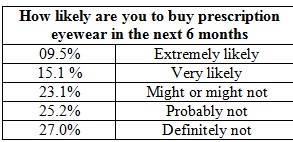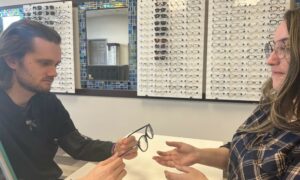 Sales in your optical will be ever challenging this summer, according to results from The Vision Council’s March 2014 Consumer Barometer report. Just 15.1 percent of respondents described themselves as “very likely” to buy prescription eyewear in the next six months. Even fewer describe themselves as “extremely likely” to buy prescription eyewear: just 9.5 percent. Twenty-seven percent said they are “definitely not” planning to buy prescription glasses. Some 25.2 percent said they are “probably not” going to buy prescription eyeglasses, and 23.1 percent said they “might or might not” buy prescription glasses.
Sales in your optical will be ever challenging this summer, according to results from The Vision Council’s March 2014 Consumer Barometer report. Just 15.1 percent of respondents described themselves as “very likely” to buy prescription eyewear in the next six months. Even fewer describe themselves as “extremely likely” to buy prescription eyewear: just 9.5 percent. Twenty-seven percent said they are “definitely not” planning to buy prescription glasses. Some 25.2 percent said they are “probably not” going to buy prescription eyeglasses, and 23.1 percent said they “might or might not” buy prescription glasses.
Let’s put The Vision Council’s March 2014 Consumer Barometer report in chart form so that it is easy to understand.

Now let’s look at the top two categories and the bottom two categories together. Looking at the bottom two categories we see that 52.2 percent of people surveyed are ranging from “probably not” to “definitely not.” Looking at the top two categories, only 24.6 percent range from “very likely” to “extremely likely.” Looking at the data this way suggests the number of glasses being sold in a practice may decrease dramatically over the next six months unless we intervene positively in this process.
Someone may suggest that people who answered in the bottom two categories just will not come into the office at all. That’s definitely a possibility, however, there is also a possibility that they will come because they want the eye health exam, they just won’t buy glasses once they get there. So, it is still important to intervene positively in this process.
Here are three things you can do today to help patients make the decision to buy new glasses today.
1) The doctor prescribes new glasses in the exam room.
Studies show that patients want the doctor to prescribe in the exam room. But, unfortunately, most doctors leave the spectacles to the staff in the optical. Let’s make sure the doctors know as much about spectacle lenses as they do about contact lenses and pharmaceutical agents.
During the transition time where doctors are learning about spectacle lenses, call the opticians into the exam room to help design the treatment plan.
2) The hand-off to the optician occurs in the exam room.
When the hand-off occurs in the exam room, patients are more likely to follow through with the doctor’s treatment plan. It significantly improves communication when all parties are hearing the same message. The further from the exam room for the hand-off, the less likely the patient will follow through with the complete treatment plan.
3) It is easy for the patient to purchase the new glasses.
Make sure your practice utilizes systems like CareCredit enabling patients to purchase services or materials today and yet have six months or longer to pay the bill. It is important to make sure the financial responsibility for patient payment is not held by your practice. You are not a banker; you are an eyecare provider. That said, you can utilize banking tools to help your patients.
Your action plan for this week is to make sure these three things are implemented in your practice in effective ways to help patients make the decision to buy new glasses today.

























